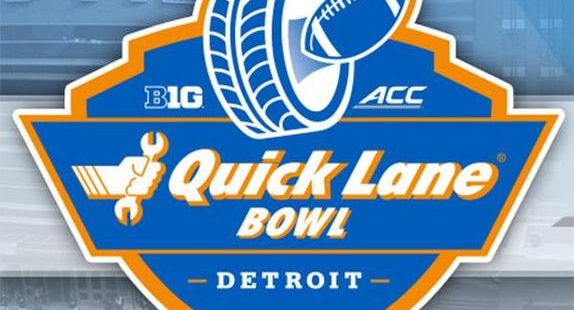
Path to Victory: Quick Lane Bowl
By Anthony Iati
In football, certain “keys to the game” never change and fans hear them on repeat. Win the turnover battle. Establish the running game on offense. Stop the run on defense. Flip field position in your favor. These are all true, especially to a Boston College team that prides itself on being fundamentally-sound, not flashy. But in order for the Eagles (6-6, 2-6 ACC) to win their December 26 clash in the Quick Lane Bowl against the Maryland Terrapins (6-6, 3-6 Big Ten), they will need to exploit specific matchups. Let’s take a look at BC’s path to winning its first bowl game in its third try under head coach Steve Addazio.
Pass Rush
Against Power-5 opponents this season, the Eagles offense averaged just 12 points per game. It’s no secret that they win with defense, and that starts up front with a really strong defensive line. Junior DE Harold Landry finished first in the nation in sacks (tied, 15.0) and forced fumbles (7). His explosiveness is a matchup nightmare for opposing offensive tackles. Maryland cannot afford to devote too much attention to Landry’s side of the line, or it risks pressure from senior Kevin Kavalec (3.5 sacks) and sophomore Zach Allen (4.0 sacks)– and that’s before even mentioning the pass-rushing skills of the linebacker trio (9.5 sacks combined). The Eagles defense placed 10th in the country with 39 sacks in the regular season.
The Terps offense, on the other hand, ranked 122nd in the country in sacks allowed, yielding 41 (3.42 per game). Watch the pocket collapse around QB Perry Hills here on a sack, and he even gets drilled while delivering a nice throw in the next highlight. The Eagles are a good bet to increase Maryland’s sacks allowed average and make Hills uncomfortable. Hills is dynamic when healthy and on the field, but that’s no guarantee for the senior quarterback. He missed two games in 2016 and had to exit four additional games early. Hills can’t be excited at the thought of dealing with such a formidable pass rush in Detroit.
Utilizing the tight end
Some stat lines for tight ends who faced Maryland’s defense this season:
Michigan’s Jake Butt: 5 receptions, 76 yards, long of 37
Penn State’s Mike Gesicki: 4 receptions, 26 yards, touchdown
Purdue’s Cole Herdman: 4 receptions, 23 yards, touchdown
Central Florida’s Jordan Akins: 2 receptions, 79 yards, including this 3rd & 13 conversion.
This is not to say Maryland turns opposing tight ends into Tony Gonzalez, and the Terps did shut down a few TEs this year. But Tommy Sweeney is going to have a chance to impact this game the way the four players above did. Sweeney’s best games have been defined by clutch moments rather than taking over the ballgame. His go-ahead scores to beat NC State and Wake Forest are one of the main reasons the Eagles find themselves bowling. In crunch time, coordinator Scot Loeffler and QB Patrick Towles will surely know Sweeney is a weapon to employ against Maryland.
Limiting game-breaking runs
Maryland’s record when rushing for over 230 yards: 6-1
Maryland’s record when rushing for under 230 yards: 0-5
Seems straightforward enough, right? How many teams ran for 230 yards against the Eagles this year? Just one, and it was Clemson on October 7, hitting 230 right on the button. With all due respect to Hills and running back Ty Johnson, they are not exactly DeShaun Watson and Wayne Gallman. On 44 attempts, Georgia Tech’s triple-option attack could not even crack 120 yards. Louisville’s potent ground game didn’t reach 230 yards, either. And part of Clemson’s total is inflated due to its commanding lead all game, one that Maryland is unlikely to have.
Specifically, Maryland’s rushing yardage tends to come in large chunks. Per ESPN, “In five of their six wins, the Terps registered at least five runs that went 15 yards or more.”Maryland’s reliance on ultra-long runs aligns nicely with BC’s defensive strengths and weaknesses. The linebackers proved their discipline in the Georgia Tech game against the triple-option, and are unlikely to get suckered into letting Maryland bust out many huge runs.
In the regular season finale, the Eagles allowed just two runs of 15 yards or more to Wake Forest. UConn’s longest run vs. BC was a paltry seven yards, and while you can mostly chalk that up to a bad opponent, remember the focus the Eagles put on containing Matthew Dayes of NC State in October. Reid’s gameplan was to keep Dayes from breaking any long gains, and to make the Wolfpack passing attack win the game. It worked to perfection; Dayes had one long run of 24 and nothing else to speak of. It’s entirely possible the coaches will try this strategy again. They have the personnel for it on defense. It would be much scarier for the Eagles to be facing a team that can air it out on their secondary, which has struggled at times (i.e. the Syracuse game).
Look at the gaping hole Perry Hills is about to sprint through in this touchdown run against Purdue. Impressive by Maryland’s offensive line, sure, but nobody has pushed around the Eagles D-line like this.
Being Better than Rutgers
One more thing:
Is Maryland on the right track? Probably. Is Rutgers’ program, which has absolutely collapsed since winning the 2014 Quick Lane Bowl, the one to use as a barometer of progress? Perhaps not. The .500 Eagles don’t provide the Terps a chance to finally beat a winning team this season, but they give coach DJ Durkin an opportunity to beat someone other than Rutgers for the first time since October 22.
WZBC Sports will have the call of the Quick Lane Bowl from Detroit on Monday at 2:30pm EST. Tune in on WZBC Newton 90.3 FM or wzbcsports.com, and keep an eye out for more preview posts leading up to the big game.


